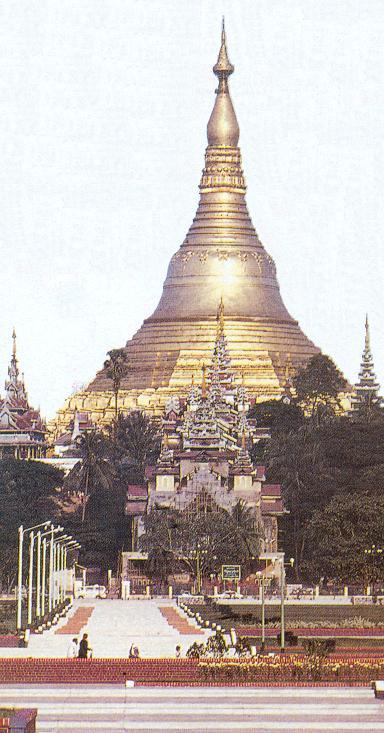
Myanmar

An introduction to the geography, economy and people of Myanmar.
Myanmar Facts
Myanmar has a tropical monsoon climate, which is cloudy, rainy and hot. There are humid summers with the southwest monsoon (June to September) which are less cloudy, scant rainfall with mild temperatures. There is lower humidity during winter when the northeast monsoon (December to April) is blowing. The capital city of Myanmar is Yangon. Its land area is about 5765 km² and its coastline is 1930 km long. Natural disasters which occur here are destructive earthquakes and cyclones, flooding and landslides during the rainy season (June to September) and periodic droughts. Myanmar's central lowlands are surrounded by steep, rugged highlands. Hkakabao Razi in the far north is the highest mountain, about 5,881 m tall. A major river here is the Ayeyarwady River. Major natural resources of Myanmar are petroleum, timber, tin, antimony, zinc, copper, tungsten, lead, coal, some marble, limestone, precious stones, natural gas and hydropower. Environmental issues here are deforestation, industrial pollution of air, soil, and water and the inadequate sanitation and water treatment contributing to disease. Major cities here are Mandalay, Mawlamyine and Yangon.
Myanmar became independent on the 4th of January 1948 from the United Kingdom. Myanmar is a socialist republic ruled by the military. The Prime Minister and Chairman of the State Peace and Development Council Gen. Than Shwe is both the head of government and the head of state. The State Peace and Development Council oversees the Cabinet and deals with executive matters. The judiciary is limited, there are remnants of the British-era legal system in place, but there is no guarantee of a fair trial as the judiciary is not totally independent of the executive. The unicameral People's Assembly or Pyithu Hluttaw is the legislative branch.
Myanmar has a mixed economy with private activity dominant in farming, light industry and transport and with substantial activity controlled be the government, mainly in energy, heavy industry and rice trading. Government policy in the last few years has aimed at revitalizing the economy after 30 years of central planning. Thus, the private sector activity has markedly increased. Foreign investment is encouraged, so far with moderate success. State enterprises remain inefficient and privatisation efforts have stopped. Official estimates of Myanmar's foreign trade are greatly underestimated because of the large black-market trade. A major ongoing problem is the failure to achieve financial stability. Myanmar remains a poor Asian country and living standards for the majority have not improved over the past decade. Myanmar's unemployment rate is about 7% (official estimate) and its inflation is at 38% (estimate). Myanmar's currency is the kyat, equal to 100 pyas. The official exchange rate to the US$ is about 6.25 kyat to 1 US$, but the actual market exchange rate is about 300.
The population of Myanmar is about 41,734,853 and the population growth rate is about 0.6%. Life expectancy is around 55 years at birth. Myanmar's main ethinc groups are Burman (68%), Shan (9%), Karen (7%), Rakhine (4%), Chinese (3%), Mon (2%), Indian (2%), other (5%). Religions in Myanmar are Buddhism (89%), Christianity (4%) (Baptists 3%, Roman Catholics 1%), Islam (4%), animist (1%), other (2%). A tourist attraction in Yangon is the Shwedagon Pagoda (below) which was made with tonnes of gold. The main language spoken in Myanmar is Burmese but other ethnic minorities have their own languages. The offical literacy rate of the total population is 83.1%, but estamates of functional literacy are much lower, about 30%.

Ideally, this website should be viewed using Internet Explorer 5.